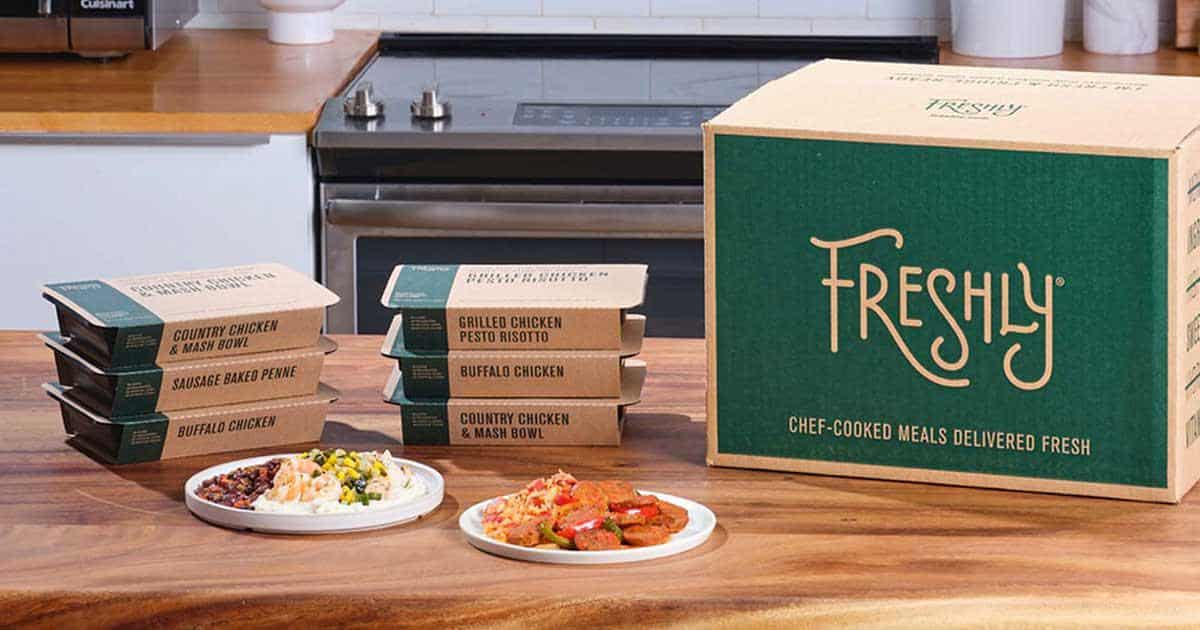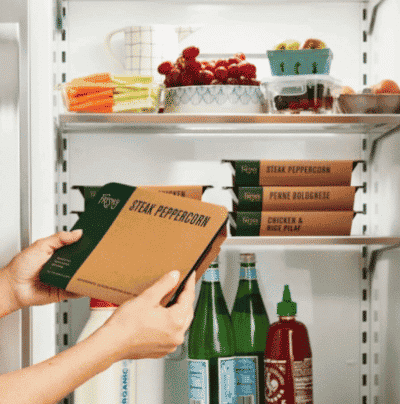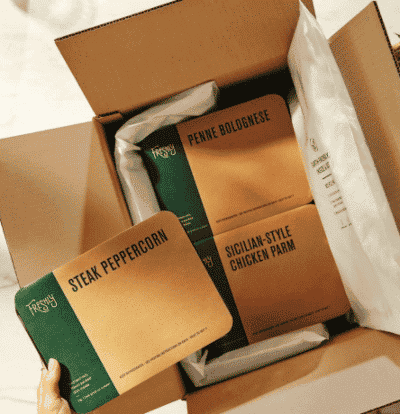

If you’re tired of grocery shopping and cooking each night, but also worry about the environmental impact of takeout and fast food, Freshly might be the perfect solution. This meal kits provide delicious meals in recyclable packaging that can also help you reduce food waste. Read our Freshly review to see if it’s worth it for you.
How We Review Meal Delivery Services
When evaluating meal delivery services, we base our review on several factors. These include their food options, ingredient sourcing, packaging, and customer reviews to ensure that they are both good for you and for the environment.
- Dietary options – We look at both the quality and variety of the recipes and whether they offered vegan, gluten-free, and dairy-free options.
- Ingredients – We research how they source their ingredients, whether they use organic, non-GMO, and locally grown products. We also prioritize important eco-friendly labels from authorities like the USDA, Non-GMO Project, and the Marine Stewardship Council.
- Packaging – The packaging for each meal is also very important. We want to know how much of their packaging is recyclable or biodegradable, and whether the brand used recycled materials in their packaging.
- Customer reviews – Finally, we look at customer reviews to see what users think about the meals and the service overall.
Freshly Overview

Freshly
A lot of meal subscription services, like Blue Apron, Purple Carrot, and HelloFresh, send meal kits with all of the necessary pre-measured ingredients to create a healthy meal at home. Freshly does all of the work before the dish is even shipped. Meals are already prepared, cooked, and delivered frozen to your doorstep. All you do is pop the tray in the microwave, and three minutes later (or less), you’re ready to eat. No mixing or baking. No dishes or clean up. Just a healthy meal ready to go.
When ordering, you simply select how many meals you want for the week, which meals you want, and your delivery date. Each meal arrives pre-cooked, so all you have to do is heat it up in the microwave (three minutes or less!) and it is ready to eat. Plus, meals can be frozen to eat at a later date if your dinner plans change.
Another advantage to Freshly is that all of their portion sizes are designed for a single serving, which can help you reduce food waste. Many companies focus on dishes that serve two to four or more people. If you live alone or it’s just you and a spouse or roommate, you don’t have to order more food than you need. Each person can pick the dishes they want; no need to agree on what you are having or worry about leftovers.
Freshly makes eating healthy easy and less wasteful. Meals are both nutritious and delicious, focusing on incorporating more vegetables and nutrient-dense ingredients and less sugar and processed foods. Furthermore, every meal is certified gluten-free by the Gluten Tolerance Group. If you have other dietary restrictions such as dairy-free, soy-free, or nut-free, the company can often accommodate those as well. While they don’t offer any vegetarian options, they do offer plenty of low-carb, high-protein entrees with plenty of veggies. They offer specific plans for dietary preferences like Protein Powerhouses, Carb Conscious, Sodium Smart, and Curb Calories.
Freshly’s Dedication to Sustainability
You want to know what you are eating, how it is grown, and where it comes from. Freshly not only ensures that all of their different meals are prepared with high-quality ingredients, they also work to reduce the footprint of their preparation facilities and packaging.
- A majority of Freshly ingredients are sourced from vendors within the United States. All meat comes from providers in the U.S. and is inspected by the USDA to verify that is free from fillers, chemical additives, and preservatives. Most produce is grown here, with the exception of some fruits or vegetables that are out of season and may be brought in from other countries.
- Because meals come already prepared in individual portions, it reduces food waste. There are no ingredients to store in the refrigerator to prepare later. Meals can also be frozen if they are not going to be eaten within a few days.
- All Freshly meals are free from 85 banned ingredients that range from artificial colors and flavors to bleached flour to partially hydrogenated oil. The list continues to grow to ensure that only the best quality ingredients are used for cleaner eating.
Corporate Citizenship at Freshly
Food insecurity and food scarcity are serious problems in the United States. Some people don’t know where their next meal will come from. One example of how Freshly gives back is through its recent partnership with Nestle and Meals on Wheels America to support senior citizens during the coronavirus pandemic. Together, Freshly and Nestle donated $500,000 to Meals on Wheels America, enabling more seniors to have access to fresh, nutritious meals that are ready to eat once heated.
Protecting the Environment: Packaging and Recycling

Freshly
Every order is carefully packaged and shipped using non-toxic, recyclable, biodegradable, and reusable materials. From the cardboard boxes meals are delivered in to the ice packs used to keep them frozen, each piece can be broken down.
- All of the cardboard – including the tray sleeves – can be recycled, or you can reuse them to store or ship packages of your own.
- The black plastic trays each meal comes in are recyclable – just rinse first!
- They use 85% biodegradable recycled denim insulation to pack their meals. This can be thrown away or reused. The plastic from the insulator bag can recycled.
- The ice packs can be refrozen and used over and over again, or they can be cut open and the non-toxic, water-soluble gel inside can be poured into a trash can, and the plastic bag recycled.
Freshly Meal Delivery Pricing
A major point of consideration when selecting meal delivery program is cost. Like most services, Freshly’s pricing is based on how many meals you order with your weekly menu. The more meals you get, the lower the cost per meal.
- Plans range from four meals per week at $11.49 a piece, to 12 meals per week at $8.49 a piece. That equates to between $46 and $102 per week excluding shipping.
- Remember that each meal is a single serving for one person; a 12-meal plan would be 12 meals for an individual, 6 meals for two people, or 3 meals for a family of four each week.
- Larger households can opt for more than one subscription to receive more than 12 meals each week.
Freshly Pros and Cons

Freshly
Freshly is ideal for individuals who don’t have the time to go to the grocery store and prepare a full meal, or those who simply don’t like to cook – or aren’t very good at it. Because each meal is a single serving, it is geared more toward individuals or smaller families. We love that Freshly uses recyclable cardboard sleeves for each tray, and that they incorporate biodegradable elements in their insulation. They definitely use less plastic than some other meal delivery services in their packaging.
One thing to consider with Freshly, though, is that there are fewer vegetarian and vegan options to choose from. Many of the meals contain chicken, turkey, or sausage. However, every meal is gluten-free and peanut-free.
A Less Wasteful Prepared Meal Option
Freshly is the largest fresh-prepared meal delivery service in the country, and it has an impressive commitment to using only high-quality ingredients and recyclable or biodegradable packaging. You can feel good knowing that your meal is made with fresh ingredients that you can pronounce. Furthermore, everything is already prepared for you, so no prep work or dirty dishes once you’re done. It is definitely a meal delivery service worth looking into if you want fast, healthy food without the excess waste of fast food or takeout.
Josh Hurst is a journalist, critic, and essayist. He lives in Knoxville, TN, with his wife and three sons. His writing on natural health, nutrition, and supplements has appeared in Health, Shape, and Remedy Review.

 233k
233k  41k
41k  Subscribe
Subscribe 